Fishing Reel Types – Which One Is Best?
UPDATED 08 MAY 2023
by Robert Ceran
Most anglers are aware that there is more than one kind of fishing reel. But a question I get a lot is: what are the different types of fishing reels, and does it really matter what type of reel you choose?
The answer is yes – absolutely! Different fishing reel types have distinct features suited for very different types of fishing.
For example, it would be almost impossible to use a trolling reel for finesse spinning techniques, and downright absurd to use a fly reel for deep sea fishing.
In this article, we’ll discuss the most important models, and how to use the different types of fishing reels.
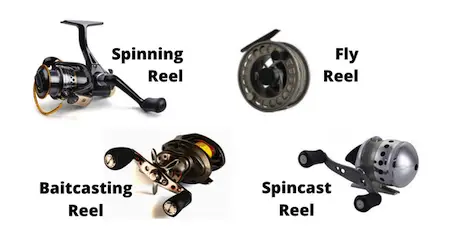
What are the 4 types of reels?
Fishing reels come in 4 main types, although these are further divided into subcategories, which will be discussed in more detail below.
- Spinning reel
- Baitcasting reel
- Spin casting reel
- Fly fishing reel
The basic build of baitcasting reels is very similar to that of surf casting reels and big game reels, and hence they are usually classified as variants of the baitcaster.
However, since they are used for very different purposes, we decided to discuss them as separate types of fishing reels.
Similarly, offshore reels are basically extra large spinning reels that are built for heavy duty applications, but since they are used for very different purposes, we also discuss them as a separate category.
Types of fishing reels compared
1. Spinning reel
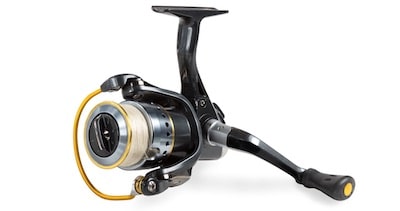
Spinning reels are the most popular reel type world wide. Not only are they very easy to use, they are also very dependable and highly versatile.
Because of this, many anglers like to use them as general purpose reels, as well as for specific fishing applications.
Most anglers take 3-4 spinner reels along on all their fishing trips, making sure to include several spinning reel sizes, in order to be prepared for all possible scenarios.
Unlike other reel types, the spool of the spinner reel doesn’t rotate. Instead, the bail arm of the reel rotates around the spool, and wraps line on to it.
One disadvantage of this setup is that you have to be careful to spool line onto a spinning reel correctly, otherwise you’ll introduce line twisting during the spooling process, which can cause untold problems out on the water.
The operation of this reel type is very easy to master, and in addition, there are many models that are highly affordable. These two traits make them an excellent reel for beginners, similar to the spincast reel.
Also, it’s generally easy to understand all the parts of a spinning reel and their functions, which is great for beginners.
Open face spinning reel:
We’re often asked, “what is an open face reel, and how is it different from a spinning reel?” The answer is simple: there is no difference.
The original name given to spinning reels was open face fishing reel. This is because the initial design of fishing reels had a closed face reel (similar to modern spin casting reels), which was later modified into an open face real.
In summary, the ease of use, dependability, and versatility of spinning reels makes them a favorite for most anglers, and they are a great choice for beginners and seasoned pros alike.
If you’re thinking about getting a spinning reel, check out our detailed reviews on the best spinning reel under $100, as well as the best spinning reel under $50.
And if you’re thinking about using them for lightweight applications, have a loot at our review on the best ultralight spinning reel.
2. Baitcasting reel
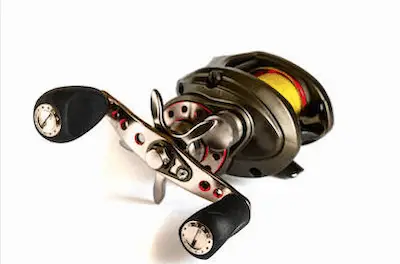
Many experienced anglers are fans of baitcasting reels, due to some of their key features.
So what are the advantages of baitcasters?
Firstly, since the spool rotates as you release the line while casting, the line doesn’t twist during the cast.
In addition, the rotating spool enables greater casting distance than most other reel types, which is a trait that many spin fishermen love about the baitcaster.
This reel also has a high degree of casting accuracy, which is ideal for casting lures close to cover.
Since baitcasters come in a wide range of sizes, you can choose the size that’s best adapted to your style of fishing, ranging from light freshwater applications to heavier saltwater fishing.
The most popular variant of the baitcaster is the low-profile baitcaster, which has been reduced in size, and has a relatively small oval spool, making it ideal for light spin fishing. Its user friendly design and light weight make it ideal for long days of casting.
The main downside is that baitcasting reels are a little more difficult to master compared to other reel types, especially compared to spinning reels.
If you don’t know how to operate them correctly, this can cause baitcaster birds nest during casting, which happens to a lot of beginners.
But that’s something a little practice can take care of easily. Once you know how to spool a baitcaster correctly, and when you’ve understood the baitcaster reel parts, you’ll be able to utilize this reel without any issues.
In summary, baitcasters provide greater power and control for casting than other reel types, and also tend to be lighter.
On the other hand, they require a bit more skill compared to spincast or spinning reels, so they aren’t one hudred percent ideal for beginners.
If you’re thinking about getting a new baitcaster, check out our review on the best baitcasting reel under $100.
3. Spin casting reel
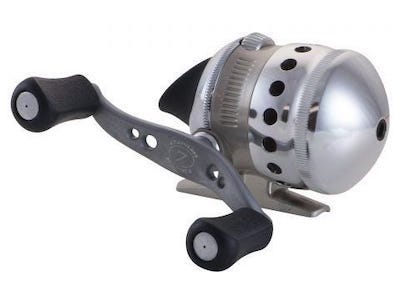
Spincast reels are ver easy to use and are therefore great for beginners. In addition, they are usually quite cheap, which is great if your interest in fishing is relatively casual.
If a child you know wants to try out fishing as a hobby, a spincast reel is a great way to get them started.
The spin cast reel has a closed spool cover which covers the line, and in order to cast your lure you need to use a release mechanism that’s operated with a push-button.
This provides reasonably accurate performance, and handles most of the more complicated tasks for you.
On the downside, spincast fishing reels tend to be relatively small, which limits their field of application. While they are fine for light freshwater fishing, you won’t be able to use them for most saltwater situations, or for going after large fish species.
Also, during the cast there’s quite a lot of friction caused by the closed spool cover. Because of this, you won’t be able to use spincasting reels to cast a lure very far.
In summary, the spin caster is a convenient and user-friendly reel to start your angling career, and it is solely intended for catching small fish.
However, as you become more experienced, and take your passion for fishing to a higher level, you’ll definitely want to switch to using one of the more advanced reel types.
The market leader in the area of spincast reels is Zebco, and if you’re looking for a spincast reel, check out our article on the best Zebco reel.
4. Fly fishing reel
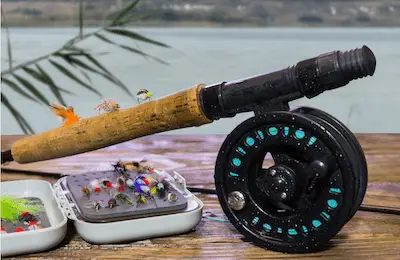
Fly reels are designed to be able to cast lures that have very little weight.
As implied by their name, they are used to fish with artificial fly lures that weigh almost nothing.
In order to cast this kind of weightless lure effectively, the weight of the fishing line is used for casting, instead of the weight of the lure. To be able to achieve this, fly fishing line is thick and strong, more like slender rope than fishing line.
The design of a fly reel is similar to that of a centerpin reel, which are a traditional type of fishing reel used by anglers in the past, but that are now hardly used anymore.
Just like a centerpin reel, a fly reel consists of a single spool that rotates around a center pin, and is designed to handle thick fly fishing line effectively.
Traditionally, fly reels were built without a drag system, so the angler had to apply drag to the line by pressing his thumb on the spool, though nowadays most of them do include a drag system.
Fly reels come in a wide range of sizes and strengths, built for fish of various sizes, ranging from brook trout to salmon.
In the past, this type of fishing was reserved for salmonid species, but nowadays it has been adapted to many other scenarios, including saltwater fly fishing for species such as mackerel and trevally.
5. Offshore reel
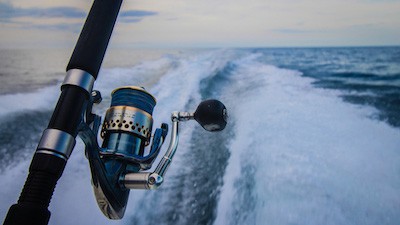
Offshore reels are basically large spinning reels that are extra powerful and extra durable.
They must be able to handle conditions that would ordinarily wreck other fishing reels.
This includes battling exceptionally strong fish, such as tuna, or sailfish. In addition, they must also be able to handle the corrosive saltwater conditions without impairment of their performance.
Because of the punishment that offshore reels need to handle without flinching, they tend to be among the priciest reel models around, especially if you want the best quality available.
But if you’re out on the ocean to catch a trophy sized fish, you’ll be glad if you have a strong offshore fish reel that won’t let you down during a long battle.
6. Trolling reel (conventional reel)
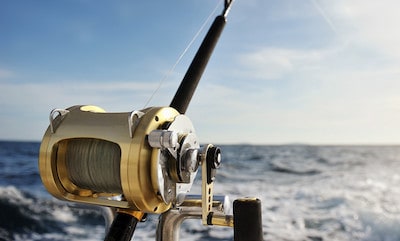
The trolling reel (also called conventional reel or big game reel) is used for offshore trolling for big game fish such as marlin or sailfish, as well as deep sea fishing.
In some cases, it is also used for heavy freshwater trolling for salmon or muskie.
The conventional reel has a very simple design with a rotating spool, and is basically built for size, strength, and the ability to hold a lot of heavy duty braided line.
One of the essential features of a trolling reel is its powerful and smooth drag system for handling extended battles with exceptionally large and strong fish.
Apart from the strong brake system that can be adjusted easily (either with a lever or star system), it also has a large capacity for heavy pound braid.
A very useful feature of big game reels is their dual speed system. You can switch to low speed while fighting strong fish, or to the higher speed when you need to retrieve your lure rapidly.
7. Surf casting reel
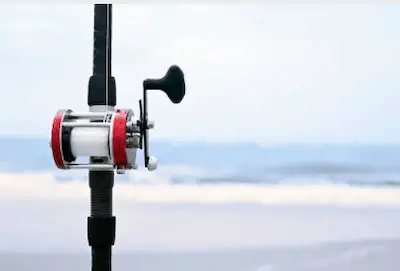
Surf fishing reels are not a distinct reel type per se, but rather a variation of one of the two main reel types adapted for surf fishing.
A surf casting reel (or saltwater casting reel) can be either a spinning reel or a baitcaster modified to have long distance casting performance.
Surf casting reels that are based on the baitcaster design have a big, round spool that can hold a lot of line, which is ideal for long distance casting. Once you master it, you can achieve record distances with the round baitcaster.
These reels are designed to handle relatively heavy line strength, plus overcome the tough conditions of the saltwater environment.
A casting reel made of graphite has excellent anti corrosive properties. Alternatively, if you choose a model made of aluminium, check that it’s anodized aluminium, and make sure to wipe off the saltwater spray after every use.
Apart from their ability to withstand corrosive saltwater and sand, surf fishing reels should provide high line capacity and long casting ability. In the case of a surf fishing baitcaster, this is achieved with a large round spool design, which can hold a long length of line.
In order to get the best performance from a surf fishing reel, make sure you use it together with a rod specifically designed for surf casting.
Finally, a surf fishing reel must be heavy enough to battle strong species such as rays, sharks and striped bass.
Which type of fishing reel is best?
A question that comes up very often is, how do I choose a fishing reel, and what is the best kind?
There is no simple answer to this question, since different types of fishing reels each have their own advantages and disadvantages (and most are designed for very specific purposes, such as fly reels, and trolling reels).
In order to choose the best reel, you need to have a clear idea of what kind of fishing you plan to do.
For example, if you’re going to do spin fishing for bass, a small to medium sized spinner reel, or a similar sized baitcasting reel should have you covered.
A great way to choose a model is to decide what line strength you’re going to need, and then choosing a reel that has the right line capacity.
Baitcaster vs spinning reel comparison
Another topic we’re very often asked about is the comparison of baitcaster vs spinning reel, and which one is the better fishing reel.
Again, there is no simple answer to this, since each type of reel has its own strengths and weaknesses.
Baitcasters are lighter than spinning reels, and provide more casting accuracy and greater casting distance.
Spinner reels, on the other hand, are much easier to master, they tend to be cheaper, and are more versatile.
Saltwater fishing reel types
The most commonly used types of saltwater reels are:
- Conventional reels
- Offshore reels
- Surf casting reels
Conventional reels are large round baitcasters, while offshore reels are large spinning reels with additional corrosion resistance features that enable them to withstand a saltwater environment. You can refer to the sections above for more details on each of these fish reels.
With that being said, you can actually use pretty much any reel type for saltwater fishing, including low profile baitcasters, spincast reels, and small spinning reels.
You just need to take special care of them, as they aren’t built for this kind of environment.
You might be surprised to hear that you can even use fly fishing reels for saltwater fishing, as fly fishing is used by some anglers to catch fish species that feed in shallow waters close to the shore. Fly fishing for tarpon and for redfish is becoming more and more popular.
However, when choosing a saltwater fish reel, it’s important to keep in mind that it should have features that make it resistant to saltwater corrosion.
These features include being built with stainless steel parts, sealed ball bearings, and a sealed reel frame.
A high quality saltwater fishing reel type comes with corrosion resistant features that enable it to handle full immersion in saltwater without being ruined, while a regular fish reel immediately would immediately seize up up if this happens to it.
Conclusion
This concludes our discussion of the most important types of fishing reels used by anglers all over the world.
Try to decide which reel to buy after identifying the kind of fishing for which you intend to use it.
It’s essential to get the right model for the right type of reel fishing, as that will really improve your success rate, as well as making the experience a lot more fun.
